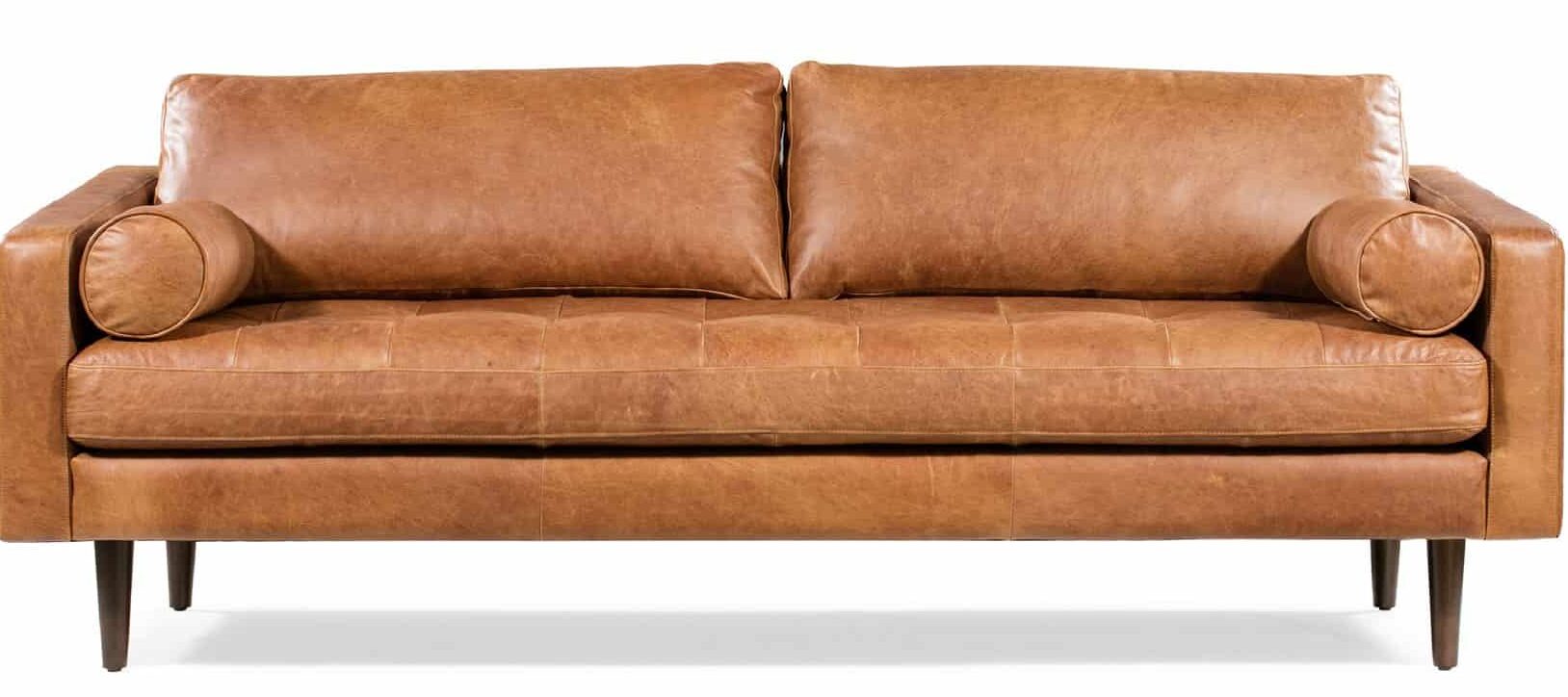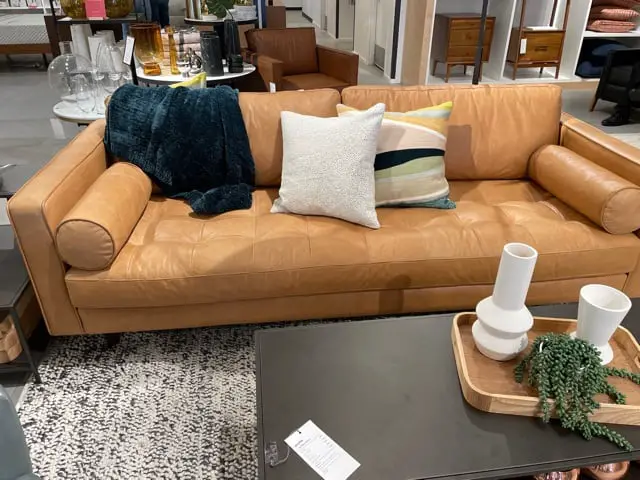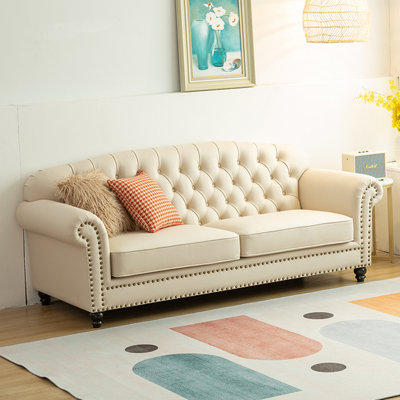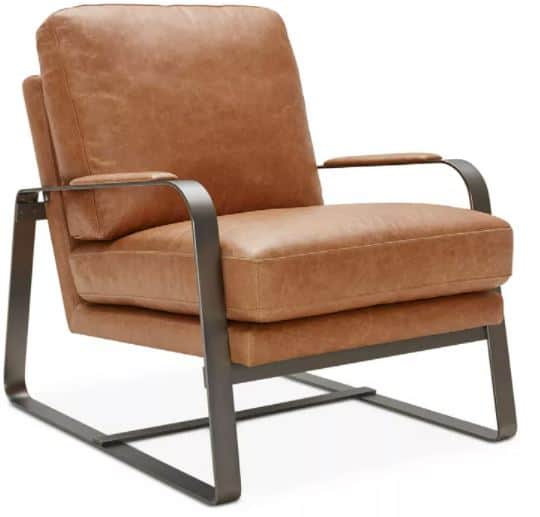Leather furniture is a stylish and timeless addition to any living space.
However, as with all prized possessions, it’s not immune to the occasional mishap.
Whether it’s a spill, a mark, or an unfortunate accident, stains on a leather couch can be particularly distressing. But with proper knowledge and technique, you can restore its pristine look.
Understanding Your Leather Furniture
Before jumping into leather stain removal, you must understand what type of leather you have. The treatment suitable for one might ruin another:

Aniline Leather: Soft and natural-looking, it is porous and susceptible to stains. Due to the porous nature of aniline leather, a specialized aniline leather cleaner should be used if some of the ideas listed in this article don't correct the stain.
Semi-Aniline Leather: It balances natural aesthetics and protection, being slightly more resistant to stains than aniline.
While more resistant than aniline leather, stains can still be a challenge. A mild leather cleaner, preferably pH-balanced, should be effective. Always spot-test any product before full application on your leather couch.
Pigmented Leather: Treated with a protective topcoat, it’s the most durable and stain-resistant. Given its protective finish, many stains sit on the surface and can be wiped away. A leather stain remover designed for pigmented leather can be used for tougher stains.
The Importance of Immediate Action When Leather Is Stained
Swift action is the key to treating any leather stain. The longer a substance remains on leather, the deeper it seeps, making removal challenging.

Leather is essentially skin. And just like human skin, it’s porous. This means that when a spill happens, the liquid doesn't just sit on the surface – it begins to permeate into the deeper layers of the leather.
The longer the spill is allowed to sit, the deeper it can penetrate, making the stain more stubborn over time. Immediate action prevents the stain from setting, preserving the leather's original look and feel.
General Rules Before Specific Treatments
Before tackling specific stains on a leather couch, adhere to these universal principles:
1. First Things First: Blot, Don’t Rub
It's a reflex action for many to gently rub away a spill, but this is a cardinal sin with leather. Rubbing can spread the liquid, enlarging the stained area and pushing the staining agent deeper into the leather. Instead, blot the spill gently.

Use a clean, dry, absorbent cloth – a microfiber cloth or white cotton cloths are excellent. Press it gently onto the spill, allowing the cloth to soak up the liquid.
2. Remove Excess Residue
If the spill involves solids (like food) or thicker liquids (like ketchup or lotion), use a flat-edged tool like a spatula or a plastic card to lift the excess gently. Remember to work from outside the stain inwards to avoid spreading it further.
3. Neutralize the Threat
Depending on the nature of the spill, plain distilled water can help. Dampen a clean microfiber cloth – not wet, just a slightly damp cloth – and gently dab the area, again working from outside the stain inwards.
This can help dilute and lift away a small amount of the staining agent, especially if it's a water-soluble spill like soda or coffee.
4. Air Dry, No Heat
Once you've addressed the initial spill on your leather couch, let the leather air dry. Avoid the temptation to speed up the process using a hairdryer or placing the furniture near a heater.
Direct heat can cause the leather to become stiff, brittle, or discolored. Instead, let nature take its course. Circulating air with a fan (not directed at the leather) can be a gentle way to expedite drying.
Tackling Common Leather Stains
Water-Based Spills (e.g., soda, coffee)
Unlike oil or dye stains, water-based spills primarily contain liquids with water as their base, such as coffee, tea, soda, and plain water.
When these spill on leather, they can leave a mark by altering its color or leaving a ringed spot, especially if the liquid has other components like sugar or coloring.
My advice is to blot the stain immediately with a dry microfiber cloth. If a mark remains, use a damp cloth, wet with distilled water, and gently wipe the area, working from outside the stain inwards.
It will be very tempting to rub the cloth on the stain, but you should blot it and not rub it!
If the stain remains after blotting, dampen a microfiber cloth with distilled water and gently wipe the stained area. Start from the edges of the stain and work your way inwards.
This dilutes any remaining residues and prevents the formation of ringed stains.
What If It Won't Come Out?
Try the following for tougher water-based stains, especially those with added ingredients like sugar or dye.
Mild Soap Solution: Mix a drop of mild soap with distilled water to create a bubbly solution. Dip a dry cloth into the bubbles – not the water – and gently wipe the stain.
Vinegar Solution: Mix equal parts of white vinegar and distilled water. The acidic nature of vinegar can help break down residues left by the stain. After applying, always rinse the area with another dry cloth dampened with distilled water to neutralize the vinegar's acidity.
Tackling Oil-Based Stains (e.g., butter, grease)
Oil-based stains are some of the most challenging to tackle on leather material, often due to their stubborn nature and how they interact with leather fibers. Leather, being a natural material, can soak up oils just like our skin does with lotions.
From butter and greasy foods to lotions and body oils, these stains can darken the leather and create spots that stand out. This can alter the leather’s appearance and sometimes its texture.
However, even these can be managed with the right knowledge and techniques.
My first piece of advice is not to not use water on any oil-based leather couch stain!
Immediately after the spill, use a clean, dry, absorbent clean cloth or paper towel to blot the affected area. Do not rub or press too hard; the aim is to lift as much oil off the surface as possible.
You can then dust the stain with talcum powder or sprinkle cornstarch, which will help to draw out the oil. Allow the powder to sit for several hours, preferably overnight. It will gradually absorb the oil from the leather.
After several hours, brush away the powder.
What About Ink Stains On Leather?
Once you get away from liquids, things get a little bit trickier when trying to remove an ink stain from leather furniture.
Ink, especially from pens, is designed to be permanent. Its molecular structure allows it to bind with fibers it comes into contact with. On porous surfaces like leather, this means the ink can sink in and set rather quickly.
If you have a kid, there's a very high likelihood that a pen with ballpoint ink might ultimately meet your leather sofa.
Some old wives' tales say that hairspray or rubbing alcohol are the best treatment for ink on a leather sofa.
However, based on my research, these chemical-based products should never be used for any sort of leather products.
Why?
The chemicals will potentially remove the color of the leather and will not remove the ink stains.
As shown in the video below, Pamela Villagomez of Leather Solutions says to avoid things like isopropyl alcohol and instead paint over the leather.
If you are willing to give it at least a shot, I would recommend testing on the back or sides of the sofa with a very small area that is not in view.
The supposed solution is to dab a cotton swab in rubbing alcohol or an alcohol-based hairspray and gently blot the stain. Once lifted, clean the affected area with a mild soap solution.
Dye Transfer Stains On Leather Furniture
At the core, dye transfer stains result from colorants moving from one material (like clothing) onto another (your leather furniture).
Certain dyes are not set properly or are of lower quality, making them more prone to transferring, especially when rubbed against another material or when exposed to heat or moisture.
Especially common from jeans or newspapers, these can be tricky. A professional-grade leather cleaner is often needed. Apply as per the product's instructions.
How Do I Remove Chocolate Stains From Leather?
So I know first hand about this one.

Somehow, I sat in a piece of chocolate that smushed into our beautiful leather chair. I'm still blaming my kids for this one.
Whatever the case, I panicked, as I had no experience removing chocolate from leather, and it looked pretty messy. I started by dabbing it with water to no avail, and then I read some stuff online about mixing dish soap with water, which worked a bit but didn't entirely remove the stain.
I kept dabbing with the soap. Ultimately, it didn't entirely remove the stain, and I probably rubbed it too hard, but the chocolate basically blended in with the leather.
And if you have a darker leather sofa, that will happen - the spill and the stain will become a part of your furniture.
So, the best advice, do your best to blot it up.
But you might not get it all, and it's probably okay because no one will notice anyway.
DIY Solutions vs. Commercial Cleaners
Sometimes, simple home solutions can work wonders to remove stains from your leather sofa.
A mixture of equal parts white vinegar and water can treat mild stains on leather.
Similarly, a mix of lemon juice and cream of tartar can work on tougher spots. Apply, let sit for a few hours, then wipe off.
However, commercial cleaners, specifically formulated for leather, offer more power.
Brands like Lexol or Leather Honey can treat stubborn stains without compromising the leather's integrity.
What Are The Best Leather Sofa Stain Remover Products?
The best leather stain remover products for a sofa often depend on the type of stain and the specific leather type.
Here are some highly rated and commonly recommended leather stain remover products:
Lexol Leather Cleaner:
This is a pH-balanced cleaner suitable for all types of leather except suede. It gently lifts dirt and surface oils without damaging the leather.
Leather Honey Leather Cleaner:
Known for its effectiveness on tough, this cleaner is also gentle on all types of leather and doesn't contain any toxic chemicals.
Chemical Guys Leather Cleaner:
This colorless and odorless cleaner removes deep-set dirt and tough stains from leather sofas without harmful effects.
TriNova Leather Cleaner:
This cleaner not only helps remove dirt and tough stains but also helps to extend the life of your leather material.
Weiman Leather Cleaner & Leather Conditioner:
This is a 2-in-1 product that cleans and conditions. It removes entire surface stains and leaves the leather feeling soft and rejuvenated.
Bickmore Bick 4 Leather Conditioner:
While primarily a leather conditioner, Bick 4 also effectively cleans leather upholstery and restores its shine without leaving any residue.
Mr. Leather Cleaner & Leather Conditioner:
This spray works on all types of leather couches, deep cleaning, shining, and protecting in one step.
Nourish Your Leather Furniture
After stain removal, it's not just about appearance.
Leather, being skin, needs its nutrients. Commercially available leather conditioners or a simple mix of white vinegar and flaxseed oil can restore its suppleness. T
This is an often-overlooked step for owners of leather couches, but is vital in maintaining the longevity and feel of your furniture.
Protection is Better Than Cure
Once you’ve dealt with stains, take measures to prevent future mishaps:
Protective Sprays: These products form a protective barrier, especially for aniline and semi-aniline leathers.
Avoid Direct Sunlight: This can cause leather to fade and dry out over time.
Regular Maintenance: Dust and vacuum your furniture regularly. Over time, minute particles can embed into leather, causing it to degrade.
When to Call in Professionals
If a stain persists after multiple treatments or you’re unsure about the leather type and the products to use, it might be time to consult a professional. They possess the expertise and specialized products to treat challenging stains without causing further damage.
Conclusion
Leather furniture is an investment. It can be a centerpiece in your home for years with the right care. Remember, swift action combined with the correct technique can mitigate most stains. Regular maintenance and protection will ensure longevity, and when in doubt, always consult an expert.


